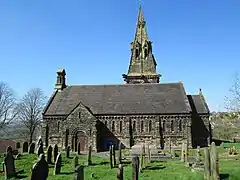Listed buildings in Brown Edge
Brown Edge is a civil parish in the district of Staffordshire Moorlands, Staffordshire, England. It contains six listed buildings that are recorded in the National Heritage List for England. All the listed buildings are designated at Grade II, the lowest of the three grades, which is applied to "buildings of national importance and special interest".[1] The parish contains the village of Brown Edge and the surrounding area. The listed buildings consist of three farmhouses, a former watermill, a church, and a coach house.
Buildings
| Name and location | Photograph | Date | Notes |
|---|---|---|---|
| Lower Stone House Farmhouse 53.08619°N 2.14606°W |
— |
Late 16th or early 17th century | The farmhouse was altered and extended in the 19th century. It is in stone, and has a tile roof with verge parapets on the west. There are two storeys and a cellar, a front of three bays, and a 19th-century timber framed extension to the east. The windows have chamfered mullions, and inside there are timber-framed partitions.[2] |
| Annats Farmhouse 53.06964°N 2.14575°W |
— |
1686 | The farmhouse is in rendered stone on a plinth, with quoins, and a tile roof with verge parapets. There are three storeys and three bays. Above the central doorway is a datestone, and the windows are casements with chamfered mullions and keystones.[3] |
| Boardmans Bank Farmhouse 53.08331°N 2.14362°W |
— |
1742 | The farmhouse is in stone on a plinth, with quoins, and a red tile roof with pitched verge parapets. There are two storeys and three bays. The central doorway has an inscribed and dated Tudor arched lintel. The windows are casements with chamfered surrounds.[4] |
| Knypersley Mill 53.09002°N 2.15692°W |
— |
1827 | The former watermill has been converted for residential use. It is in red sandstone with rusticated dressings, string courses, and a tile roof with verge parapets on corbelled kneelers. There are three storeys and four bays. The building has two doorways with segmental heads, and above the left door is a dated plaque. The windows are casements, also with segmental heads.[5][6] |
| St Anne's Church 53.08329°N 2.14299°W |
 |
1844 | The steeple was added in 1854. The church is built in stone with a tile roof, and is in Neo-Norman style. It consists of a nave, a south porch, a chancel, and a northeast steeple, and on the west gable is a bellcote. The steeple has a tower with three stages, buttresses, a west doorway, a circular stair turret with a conical roof to the northeast, a zig-zag frieze with grotesque-head corbels, gargoyles, and a square spire with paired lucarnes.[5][7] |
| Coach house north of St Anne's Church 53.08356°N 2.14316°W |
— |
1846 | The coach house is in stone and has a tile roof with verge parapets and poppy-head finials. It is built into a bank, and the north side has two storeys. On the north front there is a carriage arch with an elliptical head and a stable door. The upper floor contains three casement windows, a datestone, and a doorway, in front of which is a balcony with wrought iron railings approached from the west by external steps. On the west front is a three-sided bay window with a hipped roof.[8] |
References
Citations
Sources
- Historic England, "Lower Stone House Farmhouse, Brown Edge (1374603)", National Heritage List for England, retrieved 4 February 2020
- Historic England, "Annats Farmhouse, Brown Edge (1188586)", National Heritage List for England, retrieved 4 February 2020
- Historic England, "Boardmans Bank Farmhouse, Brown Edge (1188573)", National Heritage List for England, retrieved 4 February 2020
- Historic England, "Knypersley Mill, Brown Edge (1374604)", National Heritage List for England, retrieved 4 February 2020
- Historic England, "Church of St Anne, Brown Edge (1188577)", National Heritage List for England, retrieved 4 February 2020
- Historic England, "Coach house to north of Church of St Anne, Brown Edge (1038130)", National Heritage List for England, retrieved 4 February 2020
- Historic England, Listed Buildings, retrieved 4 February 2020
- Pevsner, Nikolaus (1974), Staffordshire, The Buildings of England, Harmondsworth: Penguin Books, ISBN 0-14-071046-9
This article is issued from Wikipedia. The text is licensed under Creative Commons - Attribution - Sharealike. Additional terms may apply for the media files.